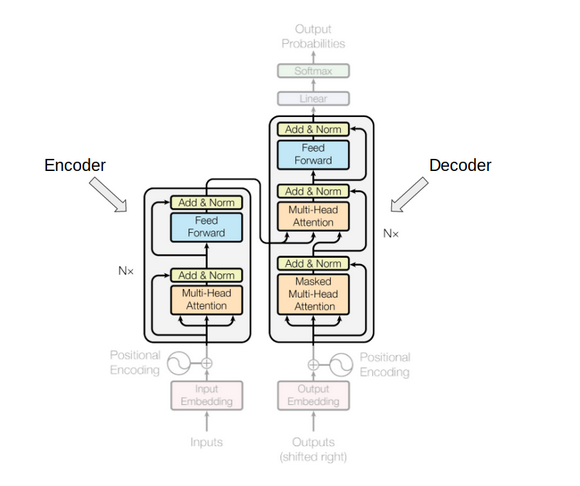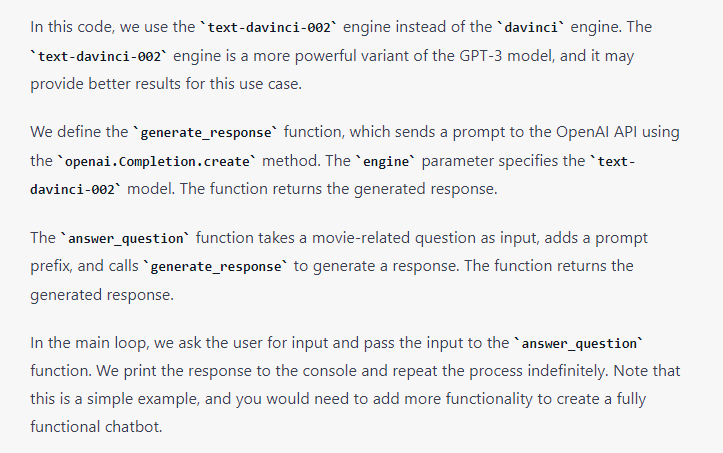 |
submitted by /u/MarkClover [link] [comments] |
Category: Chat
-
I taught the AI a new language
-
Boost Your Lead Generation with ChatGPT-Powered Chatbot

Our innovative AI-powered chatbot, powered by ChatGPT, is here to optimize the way you do business. With Presbot, you can generate 3x more customers without the hassle of a complicated chatbot builder or predefined conversation flows. Our chatbot is designed to seamlessly integrate with your website or app, making the onboarding process fast and effortless.
submitted by /u/tumidpandora
[link] [comments] -
Using a chatbot to make a simple story
Hi
I’m trying to get a chatbot to write a 50 word (could be less) story about a cat that only use the words my, the and I, or words that only use the letters s, a, t, p, i, n
Am I asking the right question? Am I missing out another instruction?
I tried in Writesonic and it included many other words, tried Chat gpt and it didn’t do anything.
Thanks in advance
submitted by /u/exo_universe
[link] [comments] -
AI chatbot generated article?

submitted by /u/electrichaiku
[link] [comments] -
Prompt/Response Subreddit
Not sure if I can advertise this here but I created a subreddit specifically for posting a prompt you used and the interesting or noteworthy response chat gpt gave back. I named it after a character the AI created in a story I asked it to write. The subreddit is r/project_ava so feel free to post there or browse others interactions to find inspiration!
submitted by /u/maxwell737
[link] [comments] -
ChatGPT: The Technicalities behind the Rising Star of Conversational AI
As pioneers in adopting ChatGPT technology in Malaysia, XIMNET dives in to take a look how far back does Conversational AI go?
Photo by Milad Fakurian on Unsplash Conversational AI has been around for some time, and one of the noteworthy early breakthroughs was when ELIZA, the first chatbot, was constructed in 1966. Pattern matching and substitution methodology were used to explore communication between humans and machines in which both parties did not understand the conversation context.
The next milestone features A.L.I.C.E in 1995, coded using AIML (Artificial Intelligence Markup Language) based on heuristic pattern matching. The Open Source community subsequently gains interest and thus actively contributed to all sorts of research repositories which brings us the vast collection of machine learning models today.

Timeline by Antoine Louis on A Brief History of Natural Language Processing Siri, Google Assistant, Cortana, and Alexa, are the successive technologies rolled out in the 20th century. They are readily accessible via our handy devices and serve as an intelligent personal assistant instead of just simple question-answering based on internet information. NLP, Natural Language Processing, and deep neural networks are the core building blocks of the technology, which allows our machines, appliances, and IOT devices to understand human language at ease. Command execution via voice recognition is the new norm where a simple instruction like “Hey Google, play me some country music!” will easily fire up your Spotify app to your liking.
Rising Star: ChatGPT
A nonprofit American Artificial Intelligence company called OpenAI was created with the common goal of developing artificial intelligence “in the way that is most likely to benefit humanity as a whole,” according to a statement on OpenAI’s website from December 11, 2015.
In November 2022, the public was introduced to ChatGPT, a pre-trained language model that had been fine-tuned on conversational data, and its jaw-dropping capabilities quickly became the talk of the town. The public has been drawn to ChatGPT because of its remarkable capacity to produce natural and compelling responses in a conversational environment, regardless of whether they are AI experts or not. In just 5 days, the AI model has amassed over one million users, prompting people to wonder how ChatGPT can provide such accurate and human-like answers.
Behind the scenes
(A) Large Language Model (LLM)

Illustration of neural network by DeepMind design and Novoto Studio It all started with a large Language Model (LLM), a type of pre-trained neural network that is designed to understand and generate natural language in a way that is similar to human language. Being one of the largest LLMs available today, ChatGPT consists of over 175 billion parameters which grant it the ability to generate text that is remarkably similar to human writing. These models are engineered to comprehend to process a large corpus of text data to learn the patterns and structures of natural language. By feeding the model a large dataset of text from Wikipedia and Reddit, the model can analyze and learn from the patterns and relationships between the words and phrases in the text. As the model continues to learn and refine its understanding of natural language, it becomes increasingly adept at generating high-quality text outputs.
Training steps like predicting a word in a sentence, be it a next-word prediction or masked language modelling are crucial in shaping a high-accuracy LLM. Both techniques are normally deployed using Long-Short Term Memory (LSTM), which consists of feedback connections, i.e., it is capable of processing the entire sequence of data, apart from single data points such as images. However, the model has its drawbacks which limit the potential of large datasets.
LSTMs have difficulty handling long-term dependencies and struggle to remember information that is many steps removed from the current input.
- Let’s say we want to train an LSTM to predict the next letter in the sentence “I love to eat pizza”. The LSTM takes in a sequence of letters as input and outputs a probability distribution over the possible next letters. If we only use a small context window (e.g. 2 or 3 letters), the LSTM may struggle to remember important information from earlier in the sentence.
- For example, if the LSTM only sees the letters “zz” as input, it may have difficulty predicting the next letter “a” because it has forgotten that the sentence began with “I love to eat”
LSTMs have restricted context window sizes. The context window is the set of inputs that the network uses to predict the next output.
- Let’s say we have a language model that uses an LSTM with a context window size of 3. The model takes in a sequence of three words as input and tries to predict the next word in the sequence.
- For example, given the input sequence “The cat sat”, the model might predict the next word as “on” if it has learned that the sentence often continues as “The cat sat on the mat”. However, if the full sentence is “The cat sat on the mat in the corner of the room”, the LSTM with a context window size of 3 would only consider “on the mat” as the input and ignore “in the corner of the room”, potentially leading to an incorrect prediction.
To address this, a team at Google Brain introduced transformers in 2017, which significantly improves the ability of LLMs to incorporate meaning, as well as the capacity to handle much larger datasets. Transformers differ from LSTMs in that they can process all input data at the same time. The model can assign varying importance to different parts of the input data in relation to any position of the language sequence, thanks to a self-attention mechanism.
(B) GPT

Prompted using Midjourney by The Decoder In 2018, openAI released a paper, “Improving Language Understanding by Generative Pre-Training,” — introducing the concept of a Generative Pre-trained Transformer (GPT), which also serves as one of the contributing factors to the significant advancement in the area of transfer learning in the field of natural language processing (NLP). Simply put, GPTs are machine learning models based on the neural network architecture that mimics the human brain. These models are trained on vast amounts of human-generated text data and are capable of performing various tasks such as question generation and answering.
The model later evolved and they released GPT-2, which is a more robust version trained on a corpus of 8 million web pages, comprising 1.5 billion parameters that facilitate text prediction. However, due to their concerns about malicious applications of the powerful technology, they released a much smaller model for researchers to experiment with, as well as a technical paper. Other than next-word prediction, notable use cases include zero-shot learning. As opposed to typical large neural models that require an insane amount of data, a “zero-shot” framework enables measuring a model’s performance having never been trained on the task.
Following two years of parameter adjustments and fine-tuning, GPT-3 was unveiled in May 2020, having been trained on a staggering 45 terabytes of text data, which ultimately translated into 175 billion parameters. It was smarter, faster, and more terrifying than anything we had seen before.

Architecture diagram of Transformer The key success of all GPT models lies within the transformer architecture, which is both encoder (processing the input sequence) and the decoder (generating the output sequence) contain a multi-head self-attention mechanism that enables the model to give different levels of importance to different parts of the sequence in order to understand its meaning and context.

A simple yet comprehensive animation by Raimi Karim illustrating the self-attention mechanism The encoder in a Transformer processes the input sequence and computes key, query, and value vectors. Attention weights are computed using the key and value vectors, while the query vector is used to produce the output. This is done by taking the dot product of the query and key vectors and scaling the result. The output is computed by taking the weighted sum of the value vectors, using the attention weights as the weights. This is then repeated in multiple layers in parallel to learn increasingly complex representations of the input, which brings about the term multi-head attention. Thus, combining the results for a final score allows the Transformer to encode multiple contextual relationships for each word in a sequence.
In spite of all this, since GPTs are trained on large data sets, they do have training data bias reflecting on the generated text. Since it is generative in nature, it has the potential to generate inappropriate content due to a lack of understanding of the true meaning of the context. Limited long-term memory will be one of the drawbacks; unlike humans, they are unable to maintain coherence and consistency in longer pieces of text or over multiple exchanges in a conversation.
(C) ChatGPT
To rectify the shortcomings, OpenAI introduced a twist of including human feedback in the training process to improve the GPT-3 model’s output to match user intent. This technique is called Reinforcement Learning from Human Feedback (RLHF), which is explained in detail in OpenAI’s 2022 paper titled “Training language models to follow instructions with human feedback”.

Source from OpenAI The figure above summarizes the steps taken by researchers to enhance GPT-3’s ability to follow instructions and accomplish tasks rather than simply predicting the most probable word. To start, a fine-tuning process is carried out, which produces InstructGPT or also known as a supervised fine-tuning model (SFT). This approach uses patterns and structures learned from labeled training data to generate responses. For instance, a chatbot trained on a dataset of medical conversations will generate informative and appropriate responses to medical-related questions based on its supervised policy.
To incentivize a chatbot to produce more suitable and favorable responses, a reward model is necessary. This model takes in a prompt and the chatbot’s responses and outputs a scalar reward based on the desirability of the response. Comparison data is collected by having labelers rank the output they prefer for a given input.
In the last stage, a random prompt is provided to the policy to produce an output, which is then evaluated by the reward model to determine the reward. This reward is then employed to modify the policy using Proximal Policy Optimization (PPO). The Rewards model decides the reward or penalty for each response produced by the chatbot and employs this reward function to steer the learning process, generating relevant, informative, or engaging responses for the user while avoiding producing inappropriate or offensive ones. These processes are then repeated through multiple iterations using Azure AI supercomputing infrastructure which completes the ChatGPT model generation.
How can you use it?
After getting familiar with the architecture behind the tools, how exactly can you implement it in your own applications, for instance, building a chatbot?
Let’s assume that we are using OpenAI’s GPT-3 model, which in their API documentation, is also known as text-davinci-002. The basic steps, including creating an OpenAI API account, setting up an environment to use the API, and programming the chatbot to interact with users.
How about asking ChatGPT to help us with this setup?

Screenshot 1: Asking ChatGPT to help with code development import openai
openai.api_key = "YOUR_API_KEY"
def generate_response(prompt):
response = openai.Completion.create(
engine="text-davinci-002",
prompt=prompt,
max_tokens=100,
n=1,
stop=None,
temperature=0.7,
)
message = response.choices[0].text.strip()
return message
def answer_question(question):
prompt = f"Q: {question}nA:"
response = generate_response(prompt)
return response
while True:
user_input = input("User: ")
bot_response = answer_question(user_input)
print("Bot:", bot_response)
Screenshot 2: Asking ChatGPT to help with code development ChatGPT not only generated the code as per my command, but it also provided some explanations and annotations to clarify some sections of the code. This indicates that anyone, whether they are a software developer or a business person, can use ChatGPT’s guidance to build small applications.
However, it is important to note that ChatGPT’s responses may not always be precise, especially in the context of code implementation. Although it has extensive knowledge of various programming languages, it can still make errors or generate incomplete or incorrect code. While ChatGPT can handle many tasks, it may not be an expert in any particular field. Therefore, it is crucial to validate the information provided by ChatGPT before relying on it. The best approach is to still ask follow-up questions or provide a detailed prompt to generate a response that better fits your use case.
What’s next?
As ChatGPT continue to make headlines ever since its grand launch in November 2022, we have seen people asking whether ChatGPT will dominate or even monopolize the entire chatbot industry due to its impressive language processing capabilities and ability to generate human-like responses.
Integrating ChatGPT into any business model is not a straightforward solution. When businesses deploy a chatbot, they typically expect it to be able to communicate with customers on their behalf. Additionally, the training data used to build the language models are only up to date as of 2021, so any new developments or changes after that may not be incorporated into the knowledge base. This raises the question of how to ensure that the chatbot powered by GPT-3 has access to the most current information relevant to the organization. While fine-tuning the model with custom data sets is an option, it’s important to keep in mind that OpenAI invested significant resources and computing power to create multiple versions of the model, and the responses generated by the model still do not meet expectations at 100% accuracy. How tolerable are the businesses when it comes to handling the unpredictable nature of generative models like GPT?
While there is no definitive answer, it’s clear that current chatbot solutions will need to elevate their offerings in order to meet evolving market demands. In the coming months, we can expect to see various chatbot providers formulate new strategies and introduce new features to ensure that their products remain competitive against ChatGPT in the industry. Instead of frowning upon whether AI will take over our jobs, let’s embrace the changes and focus on leveraging them to improve efficiency and create new opportunities for growth and innovation.
XIMNET is a digital solutions provider with two decades of track records specialising in web application development, AI Chatbot and system integration.
XIMNET is launching a brand new way of building AI Chatbot with XYAN. Join our waitlist to get early access today.
ChatGPT: The Technicalities behind the Rising Star of Conversational AI was originally published in Chatbots Life on Medium, where people are continuing the conversation by highlighting and responding to this story.
-
How to Create a Healthcare Chatbot Using NLP
Ever since its conception, chatbots have been leveraged by industries across the globe to serve a wide variety of use cases. From enabling simple conversations to handling helpdesk support to facilitating purchases, chatbots have come a long way.
If you were to put it in numbers, research shows that a whopping 1.4 billion people use chatbots today.
Without question, the chatbot presence in the healthcare industry has been booming. In fact, if things continue at this pace, the healthcare chatbot industry will reach $967.7 million by 2027.
There are several interesting applications for healthcare chatbots. If you’re curious to know more, simply give our article on the top use cases of healthcare chatbots a whirl.
It is also important to pause and wonder how chatbots and conversational AI-powered systems are able to effortlessly converse with humans. That too in a language that is simple and easy for us to comprehend.
This is where Natural Language Processing (NLP) makes its entrance.
In order to understand in detail how you can build and execute healthcare chatbots for different use cases, it is critical to understand how to create such chatbots. And this is what we intend to cover in this article.
Let’s start with the most important question.
What is NLP?
Natural language — the language that humans use to communicate with each other.
Programming language- the language that a human uses to enable a computer system to understand its intent. Python, Java, C++, C, etc., are all examples of programming languages.
Imagine a situation where you can communicate with machines and computers without having to use such programming languages. Easy and seamless. Right?
Fortunately, you don’t have to put in a lot of effort trying to imagine such a situation because NLP makes this possible.
Natural language processing is a computational program that converts both spoken and written forms of natural language into inputs or codes that the computer is able to make sense of.
NLP-powered chatbots are capable of understanding the intent behind conversations and then creating contextual and relevant responses for users.
With NLP, you can train your chatbots through multiple conversations and content examples. This, in turn, allows your healthcare chatbots to gain access to a wider pool of data to learn from, equipping it to predict what kind of questions users are likely to ask and how to frame due responses.
Interesting. Right?
We hope that you now have a better understanding of natural language processing and its role in creating artificial intelligence systems. Let’s now move on to more details.
How do healthcare chatbots using NLP work?
A chatbot that is built using NLP has five key steps in how it works to convert natural language text or speech into code. Let’s explore each of these steps and what it entails.
1. Tokenization
This is the process by which you can break entire sentences into either word. The name of this process is word tokenization or sentences — whose name is sentence tokenization. This is a method of data processing.
Extract the tokens from sentences, and use them to prepare a vocabulary, which is simply a collection of unique tokens. These tokens help the AI system to understand the context of a conversation.
2. Normalizing
Imagine that you are texting your colleague. Naturally, different people have a tendency to misspell certain words, use short forms, and enter certain words in uppercase letters and others in lowercase. Essentially, there is a lot of randomness to the way different people text.
Now, extrapolate this randomness to how people communicate with chatbots. Unless the system is able to get rid of such randomness, it won’t be able to provide sensible inputs to the machine for a clear and crisp interpretation of a user’s conversation. Normalization refers to the process in NLP by which such randomness, errors, and irrelevant words are eliminated or converted to their ‘normal’ version.
For instance:
Input: cn i book an apptmnt with my dr 2day?
Output after normalization: Can I book an appointment with my doctor today?
3. Recognizing entities
Now that a sentence has been broken down (tokenized) and normalized, the system proceeds to understand the different entities in the sentence.
Entities are nothing but categories to which different words belong. Some examples of entities include Name, Location, Organization, etc. Recognizing entities allows the chatbot to understand the subject of the conversation.
For instance, take the sentence — Mary works at Mt. Sinai Medical Hospital, North Dakota.
In this example, the chatbot would recognize Mary as a name, Mt. Sinai Medical Hospital as an organization, and North Dakota as a location.
Check out our guide on Intents vs. Entities to learn more.
4. Dependency parsing
In natural language processing, dependency parsing refers to the process by which the chatbot identifies the dependencies between different phrases in a sentence. It is based on the assumption that every phrase or linguistic unit in a sentence has a dependency on each other, thereby determining the correct grammatical structure of a sentence.
5. Generation
This is the final step in NLP, wherein the chatbot puts together all the information obtained in the previous four steps and then decides the most accurate response that should be given to the user.
Why should you consider building an NLP-based healthcare chatbot?
One of the most important things to understand about NLP is that not every chatbot can be built using NLP. However, for the healthcare industry, NLP-based chatbots are a surefire way to increase patient engagement. This is because only NLP-based healthcare chatbots can truly understand the intent in patient communication and formulate relevant responses. This is in stark contrast to systems that simply process inputs and use default responses.
You can continually train your NLP-based healthcare chatbots to provide streamlined, tailored responses. This is especially important if you plan to leverage healthcare chatbots in your patient engagement and communication strategy.
As demand for healthcare systems grows, the only way to cut down overhead costs and increase the efficiency of patient engagement is to deploy conversational AI-powered chatbots built using NLP to act as the first point of contact between your patient and healthcare practice.
Create a healthcare chatbot using NLP.
Building your own healthcare chatbot using NLP is a relatively complex process depending on which route you choose. Healthcare chatbots can be developed either with assistance from third-party vendors or you can opt for custom development.
Here’s what this means
Custom DIY Development
In this method of developing healthcare chatbots, you rely heavily on either your own coding skills or that of your tech team.
In order for it to work, you need to have the expert knowledge to build and develop NLP- powered healthcare chatbots. These chatbots must perfectly align with what your healthcare business needs.
Of course, the biggest advantage of this method is the fact that you can customize it to the extent you prefer. However, when you consider factors like time and cost, it may be wiser to consider a third-party vendor.
Building your healthcare chatbot using third-party bot builders
In case you don’t want to take the DIY development route for your healthcare chatbot using NLP, you can always opt for building chatbot solutions with third-party vendors.
For instance, Kommunicate, a customer support automation software, enables users to build NLP-powered healthcare chatbots that are not only customized to their business requirements but also can be built with ease. Their NLP-based codeless bot builder uses a simple drag-and-drop method to build your own conversational AI-powered healthcare chatbot in minutes.
You can check it out here.
Their powerful NLP chatbot builder provides a simple and intuitive interface on a powerful conversational AI system for you to build your healthcare chatbot with ease. In fact, you can build a bot using Kommunicate in just five easy steps. Here’s how:
1. Getting started
First, you need to sign in to Kommunicate using your email ID. Once you are logged in, open the dashboard and then navigate to ‘Bots.’ Click ‘Create A Bot,’ and that will take you to Kompose, Kommunicate’s bot builder.

Click ‘Create A Bot’ to start building your bot.

2. Build your bot
Choose from readily available templates to start with or build your bot from scratch customized to your requirements.

Once you choose your template, you can then go ahead and choose your bot’s name and avatar and set the default language you want your bot to communicate in. You can also choose to enable the ‘Automatic bot to human handoff,’ which allows the bot to seamlessly hand off the conversation to a human agent if it does not recognize the user query.

3. Compose the Welcome message
Once you’ve set up your bot, it’s time to compose the welcome message. The welcome message is basically how your bot greets a user. You can add both images and buttons with your welcome message to make the message more interactive.


4. Setup questions and answers
The next step is to add phrases that your user is most likely to ask and how the bot responds to them. The bot builder offers suggestions, but you can create your own as well. The best part is that since the bots are NLP-powered, they are capable of recognizing intent for similar phrases as well. The more phrases you add, the more amount of data for your bot to learn from and the higher the accuracy.

5. Test your chatbot
Your chatbot is almost ready! Now all you have to do is test it.

In the chatbot preview section, you will find an option to ‘Test Chatbot.’ This will take you to a new page for a demo.
The chatbot will then display the welcome message, buttons, text, etc., as you set it up and then continue to provide responses as per the phrases you have added to the bot.
Conclusion
Healthcare chatbots are here to stay. What we see with chatbots in healthcare today is simply a small fraction of what the future holds.
These conversational AI-powered systems will continue to play a crucial role in interacting with patients. Some of their other applications include answering medical queries, collecting patient records, and more. And with the rapid advancements in NLP, it is inevitable that going forward, healthcare chatbots will tackle much more sophisticated use cases.
If you’d like to learn more about medical chatbots, their use cases, and how they are built, check out our latest article here.
For Original Content Click here
How to Create a Healthcare Chatbot Using NLP was originally published in Chatbots Life on Medium, where people are continuing the conversation by highlighting and responding to this story.


